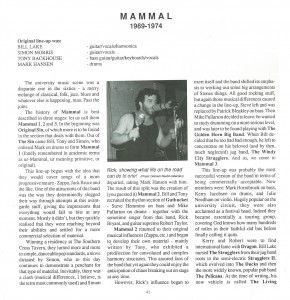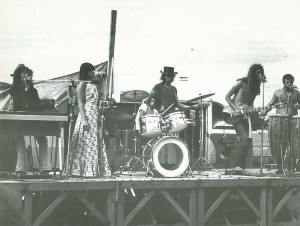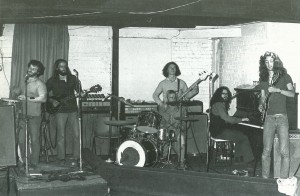‘Mammal’ were the third of three 1960s bands to feature iconic Wellington Soul-man Rick Bryant…
Mammal II, at Lucifers. The line up is basically that of MK I of the band.
(Photo: Graham Nesbit collection)



Mammal 111….a future Crocodile, two future Dragons and a future Jive Bomber
[Transcript]
MAMMAL
1969-1974
Original line-up was:
BILL LAKE – guitar/vocals/harmonica
SIMON MORRIS – guitar/vocals
TONY BACKHOUSE – bass guitar/guitar/keyboards/vocals
MARK HANSEN – drums
The university music scene was a disparate one in the sixties – a merry melange of classical, folk, jazz, blues and whatever else is happening, man. Pass the joint. The history of Mammal is best described in three stages: let us call them Mammal 1, 2 and 3. In the beginning was ‘Original Sin’, of which more is to be found in the section that deals with them. Out of The Sin came Bill, Tony and Simon, who enlisted Mark on drums to form Mammal 1 (fondly remembered in academic terms as ur-Mammal, ur meaning primitive, or original).
This line-up began with the idea that they would cover songs of a more progressive nature – Zappa, Jack Bruce and the like. One of the attractions of this band was the way they determinedly slogged their way through attempts at this avant-garde stuff, giving the impressions that everything would fall to bits at any moment. Mostly it didn’t, but they quickly realised that they were reaching beyond their abilities and settled for a more commercial selection of material. Winning a residency at The Southern Cross Tavern, they turned more and more to simple, danceable pop standards, a move dictated by Simon, who to this day continues to demonstrate a penchant for that type of material. Inevitably, there was a clash (musical differences, I believe, is the term most commonly used) and Simon departed, taking Mark Hansen with him.
The result of this split was the creation of (you guessed it) Mammal 2. Bill and Tony recruited the rhythm section of Gutbucket – Steve Hemmins on bass and Mike Fullarton on drums – together with the sometime singer from that band, Rick Bryant, and guitar supremo Robert Taylor. Mammal 2 returned to their original musical influences (Zappa, etc.) and began to develop their own material – mainly written by Tony, who exhibited a predilection for convoluted and complex harmony structures. This assured fans of the band that yet again they could enjoy the anticipation of chaos breaking out on stage at any time.
However, Rick’s influence began to exert itself and the band shifted its emphasis to working out some big arrangements of Stones things. All good rocking stuff, but again those musical differences caused a change in the line-up. Steve left and was replaced by Patrick Bleakley on bass. Then Mike Fullarton decided to leave: he wanted to study drumming on a more serious level, and was later to be found playing with ‘The Golden Horn Big Band’. When Bill decided that he too had had enough, he left to concentrate on his beloved (and by then, much neglected) jug band, ‘The Windy City Strugglers’. And so, we come to Mammal 3.
This line-up was probably the most successful version of the band in terms of being commercially acceptable. New members were: Mark Homibrook on bass, Kerry Jacobsen on drums, and Julie Needham on violin. Hugely popular on the university circuit, they were also acclaimed as a festival band. Indeed they became essentially a touring group, covering God knows how many hundreds of miles in their faithful old bus before finally calling it quits.
Kerry and Robert were to find international fame with ‘Dragon’. Bill Lake nursed The Strugglers from their jug band roots to the semi—electric Strugglers II, which evolved into ‘The Ducks’ and then’ the more widely known, popular pub band ‘The Pelicans’. At the time of writing, his new vehicle is called ‘The Living Daylights’. Rock on. Tony spent time with ‘Tapestry’ to further develop his guitar technique before moving across the Tasman with ‘The Crocodiles’. He now lives in Sydney where he runs a bistro in fashionable Glebe, and has put together an acapela group, leaving the hassles of humping gear far behind him. Rick, of course, hit the commercial jackpot in the eighties with ‘The Jive Bombers’. So, Mammal were an important element on the local music scene, spawning players of enormous durability and even some who achieved international fame.
Release:
Wait/Whisper Red Rat Records RRR/002
Album:
Beware The Man: Sam Hunt & Mammal Red Rat Records (no catalogue number)
Grateful acknowledgment to Roger Watkins for allowing us to use this material from his book When rock got rolling : the Wellington scene, 1958-1970.



